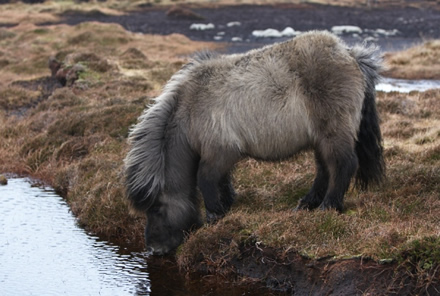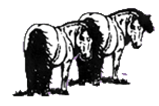History Of The UK Shetland
The United Kingdom Shetland is a very special breed. It is the real Shetland Pony known for its work in the coal and tin mines in Scotland, England and Wales and the peat fields in the Shetland Islands. These ponies are docile, kind, intelligent, sensitive, and capable of doing hard work. However, they are definitely not world class beauties!Quite the contrary, mostly they look like sturdy little trolls –wide, round and low to the ground with shaggy coats and thick manes and tails. But for the work that they do with Personal Ponies, they are spectacular and nothing warms our hearts more than the sight of one of our ponies heart to heart with a child. The Shetland has long been domesticated. No one knows for sure how they became an integral part of the history of the Shetland Islands, but about 2000 years ago there were ponies like today’s Shetland living there.
The Shetland has long been domesticated. No one knows for sure how they became an integral part of the history of the Shetland Islands, but about 2000 years ago there were ponies like today’s Shetland living there.The Islands, located just north of Great Britain, are extreme in their climate and environment. The grass is scanty, the ground is hard, rocky and wet and there is a constant cold wind. Large livestock starved and thin-bodied livestock were too delicate. Only the hardy, small, shaggy ponies survived making their short, stocky, sturdy bodies well suited for domestic work. It is our belief that prior to the division of the great northern land mass into islands and island groups, the wild Celtic ponies roamed freely and it is only in comparatively recent historic times that unique and distinct breed have developed such as the Norwegian Dun, Icelandic, Highland, Welsh, Shetland and other Mountain and Moorland pony breeds unique to the United Kingdom.
From Hauling to Peat to Working in the Mines
The UK Shetland has an amazing temperament; steady of mind and great of heart. They were originally bred to haul peat and do farm work. A Shetland 3 feet in height was able to carry a full grown man on his back for long distances (not exactly our idea of how a small pony deserves to be treated) –however this was common practice and still is on the islands. The crofters use the Shetlands for packing peat and their customary load is 130 – 140 lbs. This is remarkable when you consider the average height of these ponies is about 36-40 inches.Later they were used for draft work when roads were built and carts could be pulled along the roadways. In the late nineteenth century they were used extensively in the coal mines of Scotland and Wales. Many were exported to the United States to be used in the mines of Pennsylvania, West Virginia, Kentucky and Tennessee. Their patient, quiet, and kind ways were ideal for the work of pulling coal carts through the narrow mine shafts and they would soon replace the hundreds of women and children that were being used for this work.
It was very well known that every April from 1809 to 1842 hundreds of women and children began their contract with the many iron or coal mines across England, Scotland and Wales. Boys as young as seven could draw coal out of the narrowest mine shafts by way of girdle and chain. From a belt around their waist a chain was attached. The chain went between their legs and was attached to a large tub without wheels. On hand and foot they would crawl, pulling the tub filled with ore or coal. Both women and children were employed as “beasts of burden” – drawing coal tubs to the main shaft 14 hours a day.
In 1842, a Mines report was published. It revealed the conditions of work and life in mining communities, which had not been previously noticed by the public. As a result of this report, the 1842 Mines Act was established which prohibited females and boys under age ten from working underground.
 When the labor laws were enacted, the Shetland pony quickly replaced the children they would serve later in their history. Immediately following the 1842 Mines Act, Shetland Ponies were exported from their homeland by the thousands and employed for the work that woman and children were no longer allowed to do. Shetlands are small in stature, heavy boned and sure footed. This along with their strength and temperament made them ideal for pulling tubs through the narrow mine shafts.
When the labor laws were enacted, the Shetland pony quickly replaced the children they would serve later in their history. Immediately following the 1842 Mines Act, Shetland Ponies were exported from their homeland by the thousands and employed for the work that woman and children were no longer allowed to do. Shetlands are small in stature, heavy boned and sure footed. This along with their strength and temperament made them ideal for pulling tubs through the narrow mine shafts.The best and stoutest were the ones sent to the coal mines where large profits would be made selling them for mine work. This was very attractive to farmers on the Shetland Island who lived at poverty level and could not afford to keep their best ponies. It was mostly male ponies (stallions) that were lowered into the mines at age four and remained underground the rest of their lives – sometimes as long as 30 years. Tens of thousands of stallions worked together – certainly a testament to their kind nature and willingness to work for their human companions. The ponies would travel more than 3000 miles over the course of a year and haul as many tons of ore and coal.
Lord Londonderry Establishes the Best of the Best Breeding Program
In 1870 the Fifth Marquis of Londonderry, a colliery owner, established a Stud. The sole purpose of the Stud, located on the Islands of Bressay and Noss was to breed “Pit Ponies”. No expense was spared in purchasing Shetland Stallions and mares from the Islands and the best of the best came to be the foundations breeding stock for the Londonderry Stud. The formula for success in the development of the “Londonderry” pony was to breed a pony with “as much weight as possible, and as near to the ground as can be got” without defects of conformation. Temperament was not compromised, a tractable pony being essential for the work asked of him.
The Shetland Pony Stud Book Society began in 1890 to preserve the breed from the drain of the best stallions exported to the coal mines in the 1850s. It accepted only ponies less than 42 inches high, which encouraged breeders not to breed bigger Welsh like ponies.
The Mechanization of the Mines
As the mines became mechanized, fewer ponies were needed underground. Ponies bred at the Londonderry Stud were sold to breeders in the United Kingdom as well as breeders and mine owners in the United States. The Londonderry Stud was finally dispersed in 1899.Up until the later part of the 1970s, ponies still worked in isolated underground mines throughout Britain. Today a few Shetlands still work in tin mines in Wales, but for the most part the mines pony was out of a job when the mines became mechanized.
After World War I, the British started breeding Shetlands as riding ponies for children and riding and driving them became popular. Queen Elizabeth and her siblings rode Shetlands and the Queen Mother was Patroness of the breed until her death.
In 1956 the Shetland Islands Premium Stallion scheme was put into effect. The Department of Agriculture provided a quality registered stallion to seven Shetland Islands on the common grazing grounds where Shetlands were allowed to roam. It also prohibited the use of inferior studs, ensuring foals of greater value.



